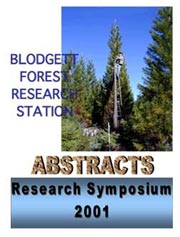ABSTRACT 19
Blodgett Forest Stream Flows and Temperatures
Frieder G. Schurr
Center for Forestry, University of California, Berkeley, Blodgett Forest Research Station, 4501 Blodgett Forest Road, Georgetown, CA 95634, (530) 333-4475, fax: (530) 333-2012, e-mail: freschur@nature.berkeley.edu
|
|
|
Blodgett Forest Research Station currently monitors three stream gauging stations on the forest, two with associated rain gauges. The stations on Bacon and Dark Canyon creeks have been operating since February 1995 and have the two rain gauges with them. The station on Gaddis Creek was installed in late 1997. All the gauges are installed near the lowest end of the drainage that is still on Blodgett Forest. In 1997 water and air temperature sensors were added to each gauging station. Water temperature on these creeks as well as on Mutton  Creek, Deep Canyon Creek and Pilot Creek were intermittently monitored during the summer months between 1994 and 1997 with Hobo temperature sensors at various points along the streams. Creek, Deep Canyon Creek and Pilot Creek were intermittently monitored during the summer months between 1994 and 1997 with Hobo temperature sensors at various points along the streams.
Flow rates in the 2nd Order streams range from lows of between 0.5 to 1.5 cubic feet per second during the late part of September and early October to highs of well over 100 cfs during the large rain on snow event of New Years 1997.
Water temperatures at the gauging stations of the 2nd order streams range from lows in the mid 30o F range during extreme cold spells in the winter to highs in the mid 50o F during the hottest parts of July and August. These temperatures are well within suitable habitat ranges for local fish species. Air temperatures immediately adjacent to the streams at the gauges at these times are in the single digits to mid teens and in the low nineties receptively.
Water temperatures along the entire lengths of the perennial portions of the streams may reach highs in the low 60’s in mid summer. However, the upper reaches of these streams frequently dry up in during the summer months. Water temperatures in these portions of the streams may exceed 70 degrees just prior to this point.
In summary, stream flows on Blodgett Forest can vary by up to two orders of magnitude during the course of an average year and water temperatures can vary by about 20 degrees during the same period. Flows and temperatures are adequate for maintaining fish populations in most stretches of the streams during the entire year although headwater reaches may not be available due to low water conditions during the summer and fall months.
|
|
|

 Creek, Deep Canyon Creek and Pilot Creek were intermittently monitored during the summer months between 1994 and 1997 with Hobo temperature sensors at various points along the streams.
Creek, Deep Canyon Creek and Pilot Creek were intermittently monitored during the summer months between 1994 and 1997 with Hobo temperature sensors at various points along the streams.



